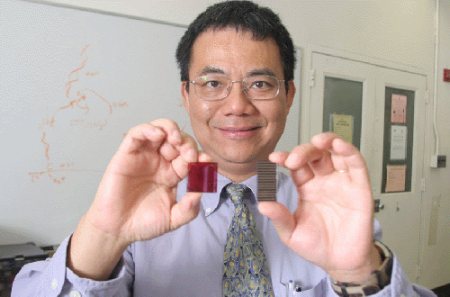According to a report by the Massachusetts Institute of Technology (MIT) "Technical Review" magazine, scientists at the University of California, Los Angeles (UCLA) have developed a cheap plastic solar cell with a photoelectric conversion efficiency of 10.6%, breaking the team last year. The month created 8.6% of the photoelectric conversion efficiency.

Yang Yang and he developed plastic solar cells.
Plastic solar cells have many advantages: they are soft, lightweight, and inexpensive, but their performance cannot match that of conventional solar cells made of inorganic materials such as silicon. The research team led by Yang Yang, a materials professor at the University of California, Los Angeles, hopes to create a plastic solar cell that rivals thin-film solar cells. Finally, they used a new type of PV plastic developed by Japan's Sumitomo Chemical Industry Co., Ltd. to produce a plastic solar cell with a conversion efficiency of 10.6%. Recent research shows that later scientists can use these "picky" polymer materials to create more efficient batteries.
The new plastic solar cell contains two layers that can handle different wavelengths of light: one layer of plastic can handle visible light and one layer of plastic can handle infrared light. Yang Yang said: "The spectrum of solar energy is very wide. From near-infrared to far-infrared to ultraviolet, a single solar module can't handle it at all."
At present, the best inorganic solar cell is also a multi-layer device, but it has been facing many challenges in order to produce a multilayer organic solar cell. Allen Jay Haeger, who won the 2000 Nobel Prize laureate for his discovery of conductive polymers, said that the polymer can be printed from a solution, just as ink marks on paper, which is the same A major advantage of technology is also a flaw. He said: “Manufacturing multi-layer organic solar cells does not require high temperatures and the manufacturing process is simple, but finding the right solvent for printing on each layer of the battery without penetrating into the underlying layer requires skill. The more layers there are, the The more complicated it becomes. In addition, it is also a challenge to match the electrical properties of each layer."
Yang Yang hopes to create a plastic solar cell with a photoelectric conversion efficiency of 15%. He said that when solar cells are out of the laboratory for commercial production, their efficiency will be reduced by about one-third. Therefore, the conversion efficiency of polymer solar cells with a conversion efficiency of 15% in laboratory tests may be only in practical applications. It is 10%. Yang Yang believes that plastic solar cells with a photoelectric conversion efficiency of 10% should be able to compete with thin-film solar cells.
Air Separation Plant,Oxygen Generation Plant,Argon Generation Plant
Cylinder,TABLE TOP GAS STOVE Co., Ltd. , http://www.nscylinder.com
